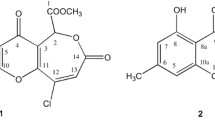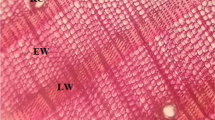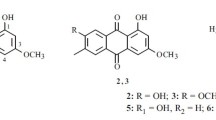Abstract
Methanolic extracts from long English cucumber leaves were fractionated and tested for their fungitoxicity by direct bioassay againstCladosporium cucumerinum on TLC plates. After separation by several preparative TLCs and flash chromatography and purification through reverse-phase HPLC, a crystalline compound possessing antifungal properties was isolated and identified asp-coumaric acid methyl ester. This antifungal compound was found to increase following infection and treatment with Milsana®, which could explain in part the prophylactic properties of the natural inducer. As such,p-coumaric acid methyl ester is the first identified compound to be associated with phytoalexin-like behavior in cucumber.
Similar content being viewed by others
REFERENCES
BAILEY, J. A., andBURDEN, R. S. 1973. Biochemical changes and phytoalexin accumulation inPhaseolus vulgaris following cellular browning caused by tobacco necrosis virus.Physiol. Plant Pathol. 3:171–177.
BANDARA, R. B. M.,HEWAGE, C. M.,KARUNARATNE, V., andADIKARAM, N. K. B. 1988. Methyl ester of para-coumaric acid: Antifungal principle of the rhizome ofCostus speciosus.Planta Med. 54:477–478.
BARANOWSKI, J. D., andNAGEL, C. W. 1982. Inhibition ofPseudomonas fluorescens by hydroxycinnamic acids and their alkyl ester.J. Food Sci. 47:1587–1589.
BARANOWSKI, J. D., andNAGEL, C. W. 1983. Properties of alkyl hydrocinnamates and effects onPseudomonas fluorescens.Appl. Environ. Microbiol. 45:218–222.
BARANOWSKI, J. D., andNAGEL, C. W. 1984. Antimicrobial and antioxidant activities of alkyl hydroxycinnamates (alkacins) in model systems and food products.Can. Inst. Food. Sci. Technol. J. 17:79–85.
BENNER, J. P. 1993. Pesticidal compounds from higher plants.Pestic. Sci. 39:95–102.
BENNETT, R. N., andWALLSGROVE, R. 1994. Secondary metabolites in plant defense mechanisms.New Phytol. 127:617–633.
CHÉRIF, M.,ASSELIN, A., andBÉLANGER, R. R. 1994. Defense responses induced by soluble silicon in cucumber roots infected byPythium spp.Phytopathology 84:236–242.
DAAYF, F.,SCHMITT, A., andBÉLANGER, R. R. 1995. The effects of plant extracts ofReynoutria sachalinensis on powdery mildew development and leaf physiology of long English cucumber.Plant Dis. 79:577–580.
DAAYF, F.,SCHMITT, A., andBÉLANGER, R. R. 1997. Evidence of phytoalexins in cucumber leaves infected with powdery mildew following treatment with leaf extracts ofReynoutria sachalinensis.Plant Physiol. 113:719–727.
DALISAY, R. F., andKUC, J. A. 1995. Persistence of induced resistance and enhanced peroxidase and chitinase activities in cucumber plants.Physiol. Mol. Plant Pathol. 47:315–327.
DERCKS, W., andBUCHENAUER, H. 1986. Untersuchungen zum Einfluss von Aluminiumfosetyl auf den pflanzlichen Phenolstoffwechsel in den Pathogen-Wirt BeziehungenPhytophthora/Fragaria-Erdbeere undBremia/Lactuca-Salat.J. Phytopathol. 115:37–55.
DIK, A. J., andVAN DER STRAAY. 1995. The effect of milsana on cucumber powdery mildew under Dutch conditions.Med. Fac. Landbouww. Rijksuniv. Gent. 59:1027–1034.
GEIBEL, M. 1995. Sensitivity of the fungusCytospora persoonii to the flavonoids of Prunus cerasus.Phytochemistry 3:599–601.
GRODZINSKA-ZACHWIEJA, Z.,ZHORNIAK-NOWOSIELSKA, I.,MARCISZEWSKA, M., andGATKIEWICZ, A. 1976. Antiviral activity of caffeic acid in in vitro studies.Acta Biol. Cracov. Ser. Bot. 19:29–33.
GUPTA, S. K., andBANERJEE, A. B. 1976. Isolation of ethylp-methoxycinnamates, the major antifungal principle ofCurcuma zedoaria.Lloydia 39:218–222.
HAMMERSCHMIDT, R., andKUC, J. 1982. Lignification as a mechanism for induced systemic resistance in cucumber.Physiol. Plant Pathol. 20:61–71.
HERGER, G., andKLINGAUF, F. 1990. Control of powdery mildew fungi with extracts of the giant knotweed.Reynoutria sachalinensis (Polygonaceae).Med. Fac. Landbouww. Rijksuniv. Gent. 55:1007–1014.
HERGER, G.,KLINGAUF, F.,MANGOLD, D.,POMMER, E. H., andSCHERER, M. 1988. Efficacy of extracts ofReynoutria sachalinensis (F. Schmidt) Nakai (Polygonaceae) against fungal diseases, especially powdery mildews. (in German),Nachr. Dsch. Pflanzenschutzdeinst (Braunschweig) 40:56–60.
HIGGINS, V. J.,HOLLANDS, J., andBATES, D. K. 1995. Phytoalexins in forage legumes: Studies on detoxification by pathogens and the role of glycosidic precursors in roots, pp. 391–403,in M. Daniel and R. P. Purkayastha (eds.). Handbook of Phytoalexin Metabolism and Action. Marcel Dekker, New York.
HIROAKI, O.,YOSHINORI, N.,HIROKO, J.,TAKESHI, K., andGENJI, I. 1993. Preparation ofp-hydroxycinnamic acid derivatives and skin-lightening cosmetics containing them (patent). Kao Corp., Jpn. Kokai Tokkyo Koho 05105620 (93105620), CI.: A61K7/48, Appl.: 91/266405.
MACKO, V.,SAPLES, R. C.,RENWICK, J. A. A., andPIRONE, J. 1972. Germination self-inhibitors of rust uredospores.Physiol. Plant Pathol. 2:347–350.
NDUBIZU, T. O. C. 1976. Relations of phenolic inhibitors to resistance of immature apple fruits to rot.J. Hortic. Sci. 51:311–316.
NICHOLSON, R. L., andHAMMERSCHMIDT, R. 1992. Phenolic compounds and their role in disease resistance.Annu. Rev. Phytopathol. 30:369–389.
RHODES, M. J. C. 1994. Physiological roles for secondary metabolites in plants: Some progress, many outstanding problems.Plant Mol. Biol. 24:1–20.
SCHNEIDER, S., andULLRICH, W. 1994. Differential induction of resistance and enhanced enzyme activities in cucumber and tobacco caused by treatment with various abiotic and biotic inducers.Physiol. Mol. Plant Pathol. 45:291–304.
SIEGRIST, J.,JEBLICK, W., andKAUSS, H. 1994. Defense responses in infected and elicited cucumber (Cucumis sativus) hypocotyl segments exhibiting acquired resistance.Plant Physiol. 105:1365–1374.
VAN ETTEN, H.,MANSFIELD, J. W.,BAILEY, J. A., andFARMER, E. E. 1994. Two classes of plant antibiotics: Phytoalexins versus phytoanticipins.Plant Cell 6:1191–1192.
Author information
Authors and Affiliations
Rights and permissions
About this article
Cite this article
Daayf, F., Bel-Rhlid, R. & Bélanger, R.R. Methyl Ester ofp-Coumaric Acid: A Phytoalexin-Like Compound from Long English Cucumber Leaves. J Chem Ecol 23, 1517–1526 (1997). https://doi.org/10.1023/B:JOEC.0000006419.22408.65
Issue Date:
DOI: https://doi.org/10.1023/B:JOEC.0000006419.22408.65




